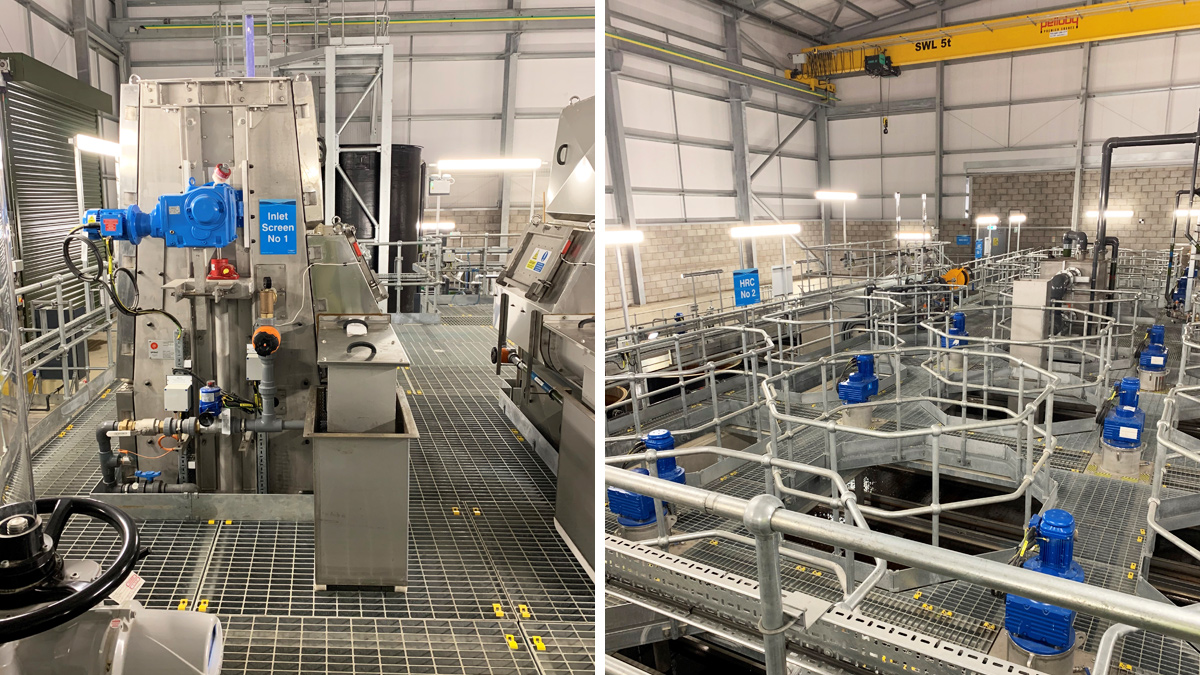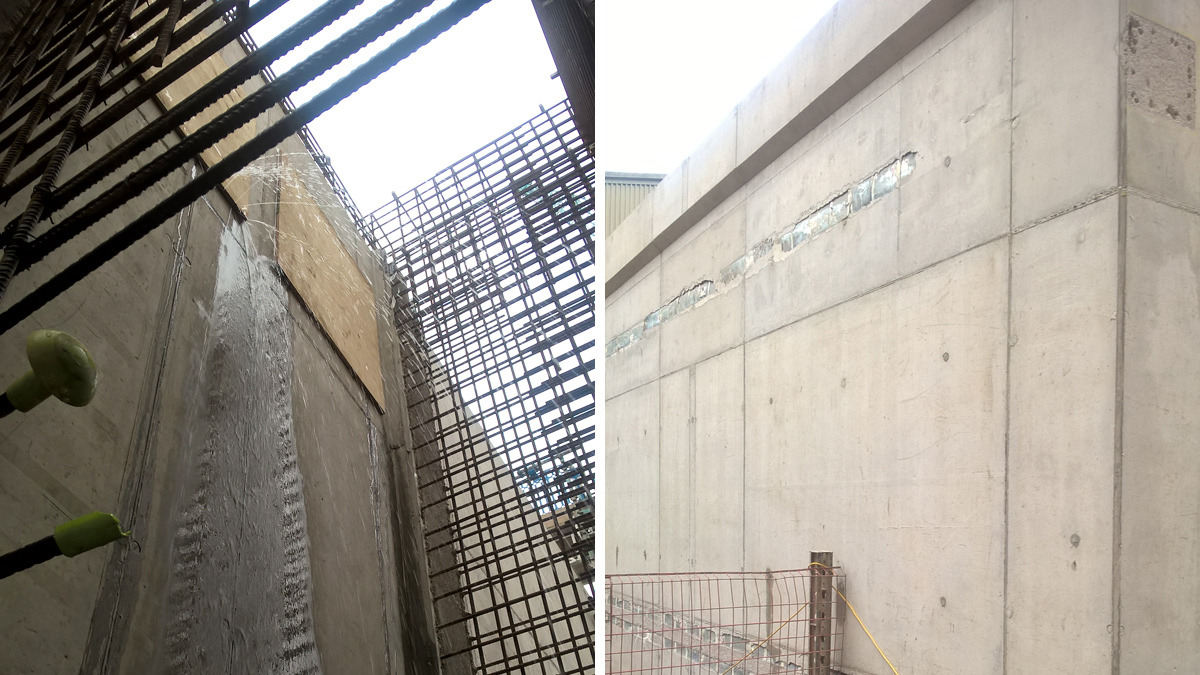Langsett WTW (2020)

Langsett WTW waste brine tanks and salt saturators - Courtesy of MS2 JV
Yorkshire Water’s Langsett Water Treatment Works (WTW) is located 17km north-west of Sheffield in South Yorkshire, on the edge of the Peak District National Park. The WTW treats raw water which is extracted by gravity from two upland impounding reservoirs at Langsett (adjacent to the WTW) and nearby Midhope (approximately 1km south-east of the site). In low water conditions, extraction is supplemented using low-lift booster pumps. The works supplies around 60 MLD to the Sheffield and Barnsley areas, and in normal operation approximately 85% of this originates from the larger Langsett Reservoir.
Background
The existing Langsett WTW dates from the mid-1980s and is located within the remains of the quarry from which rock was extracted for the original reservoir construction between 1898 and 1904. In common with many upland sources within the YWS area, both Langsett and Midhope have suffered from increasing levels of raw water colour, originating from the extensive peat moorlands within the reservoir catchments. The colour issue is more prevalent in the Langsett raw water than Midhope, and this is compounded at the WTW due to the Langsett raw water constituting the majority of the flow into the works.

Site clearance – Courtesy of MS2 JV
The existing treatment process at Langsett WTW comprises:
- Inlet works.
- Chemical dosing/coagulation.
- Clarification using superpulsators.
- Rapid gravity filtration.
- Manganese removal.
To offset the impact of deteriorating raw water colour and to continue to supply water of an acceptable quality to the distribution network, increasing amounts of coagulants have been used within the treatment process to aid the flotation and filtration of organic compounds. This can result in solids overloading of the existing WTW which in turn has an adverse impact on the treatment capacity. From current trends, YWS forecast that raw water colour is liable to continue to deteriorate over time, leading to a further reduction in the works capacity.
An additional associated concern related to coloured upland raw water is the risk of formation of trihalomethanes (THM), classified as Group B carcinogens, resulting from the chlorination of colour not removed by existing treatment process.
Regulatory undertaking
YWS had agreed an Undertaking and associated compliance date of 31 December 2019 with the Drinking Water Inspectorate (DWI) to address the raw water colour issues at Langsett WTW.

MIEX building steel frame – Courtesy of MS2 JV
Process solution
YWS’s solution to the raw water problem was to install a magnetic ion exchange (MIEX®) plant as a pre-treatment process upstream of the existing WTW. MIEX is an innovative ion exchange process technology that has been developed by and supplied through US-based IXOM Watercare Inc, and is used to remove dissolved organic carbon (DOC) and to reduce disinfection by-products (DBPs) such as THMs at water treatment plants. Langsett will be YWS’s fourth MIEX plant and is the first of their ‘next generation’ MIEX installations, the only one of its type in the UK. It incorporates enhancements based on ten years of operational learning from existing plants at Albert WTW (Halifax), Ewden WTW (Sheffield) and Graincliffe WTW (Bradford), as well as IXOM’s improvements in resin technology and performance.
The MIEX process uses a specially developed magnetised ionic resin to attract the negatively charged dissolved organic carbon (DOC) compounds that can cause colouration in untreated water. The raw water enters a high rate contactor vessel where it is mixed with MIEX resin and the ion exchange process takes place, as negatively charged target ions within the DOC exchange for chloride ions on the resin’s active sites in a process known as adsorption.

(left) inlet screens and (right) high rate resin contactors (HRCS) – Courtesy of MS2 JV
Flow then enters lamella separators, where the MIEX treated raw water is separated from the resin; the magnetic resin beads forming large agglomerates that settle to the base of the unit. Resin is recycled to the contactor with a small proportion being sent for regeneration; an integral part of the process which involves the resin being separated from the water and mixed with brine to exchange with chloride target anions off the resin. The brine is generated on site as part of the process using salt saturators.
The MIEX process requires a compact physical footprint and results in a small waste stream. The special gold-based resin is a costly component at approximately £12,000/tonne, but it can be continuously regenerated within the process for re-use, with only a nominal requirement for replacement of small quantities which get permanently lost as consequence of normal process operation.
At Langsett WTW, the MIEX process will act as a raw water pre-treatment phase, upstream of the existing treatment processes and with complex connections to existing live raw water mains to feed the new process. These critical connections were designed to limit the duration of any associated shut-down periods for the existing WTW. In addition to the MIEX plant, the site enhancements included:
- A new inlet works at the head of the magnetic ion exchange (MIEX) process.
- A new site service water and washwater pumping station and associated site-wide distribution pipework.
- A new power upgrade system linked into the new and existing works (comprising HV transformer, LVDB, standby generator and fuel oil reception/storage area).
- New site access roads.

Regen tanks 1 to 3 – Courtesy of MS2 JV
Project design and delivery
The scheme is being delivered by MS2JV (a YWS Tier 1 Framework Delivery Partner design/build joint venture between Sweco and Morgan Sindall) and has been procured by YWS through an NEC Option C target cost delivery contract under their AMP6 Large Delivery Framework. Simultaneously, YWS entered into a NEC Professional Services Contract directly with IXOM to supply the MIEX process design and equipment; MS2JV then ordered the MIEX plant and media direct from IXOM. YWS’s overall project budget was £22.5m.
The outline project feasibility design was taken by MS2JV and refined to improve constructability and process efficiency, as well as to maximise the use of gravity-fed raw water from the reservoirs. A fully detailed design was developed including use of a 3D design model to incorporate all construction works and M&E installation packages; this proved to be of great benefit in clash detection for a project with considerable and complex M&E components, while also assisting in virtual realisation and assessment of human factors such as access and lifting.
Table of CDM appointees, key contractors and key suppliers
- Principal contractor/designer: Morgan Sindall Sweco (MS2JV)
- Process designer/supplier: IXOM Watercare Inc.
- Commercial consultant: Turner & Townsend
- Civil design/installation: Clugston Construction
- Civil design/installation: HBPW Consulting Engineers
- Mechanical design/installation: Alpha Plus Ltd
- HV Electrical design/installation: Integrated Utility Systems (IUS)
- LV Electrical design/installation: Circle Control & Design Systems
- Surge analysis: Hydraulic Analysis
- Standby generator/fuel system: WB Power Services (WBPS)
- Motor control centres: Lintott Control Systems
- Inlet screens: SPIRAC Ltd
- Air compressors: Aerzen Machines
- GRP tanks and vessels: Forbes Technologies
- Overhead crane: Peter Cassidy (Leeds)
- Access metalwork: GT Fabrications
- GRP kiosks: Quinshield
- Rockfall netting: CAN Geotechnical
- Pressure-tight doors for safe access: Huber Technology

Construction of tanks in the MIEX building – Courtesy of MS2 JV
Process safety requirements
Compliance with YWS’s process safety requirements was paramount throughout development of the detailed design, and as standard, every area of the proposed works underwent the IChemE 7-stage hazard study process including different stages of detailed hazard study and access, lifting and maintenance reviews. Throughout the design process, Yorkshire Water, MS2JV and IXOM worked together with the wider supply chain to maximise the potential for programme and safety/accessibility benefits resulting from constructability improvements.
Construction and delivery
Construction work began on site in November 2017 and was completed in July 2019. The MIEX Plant comprises a complex reinforced concrete substructure which is set substantially below ground level within the existing quarry floor. This was to maximise available reservoir capacity via gravity feeds from the Langsett and Midhope Reservoirs, as well as to minimise visual amenity impact with respect to the site’s location immediately adjacent to the Peak District National Park. In total, approximately 6000m3 of fractured sandstone was excavated, crushed, screened and re-used in construction on site, thereby avoiding hundreds of potential off-site vehicle movements in a highly environmentally sensitive location.
Rockfall netting: The proximity of the existing 8m high quarry face immediately adjacent to the works area necessitated consideration of measures to protect personnel and assets from potential rockfalls both during construction and after completion of the works. To address this, a system of temporary and permanent rockfall netting was installed around the working area by CAN Geotechnical. This netting is to be tested on a yearly basis to ensure continued safety.
Substructure: The MIEX plant substructure comprises a multi-level/multi-compartment water-retaining reinforced concrete box structure up to 8m in depth, incorporating various chambers, channels, openings and cast-in pipework connections. Even though the structure was significantly rationalised and simplified from the outline design concept, the layout remained complex and consequently a considerable number of concrete pours were required to form the finished structure. Approximately 1430m3 of structural concrete and 200t of reinforcement were used in the substructure construction, requiring a total of 35 (No.) individual concrete pours.

Construction of tanks in the MIEX building – Courtesy of MS2 JV
Superstructure: The substructure was substantially completed and hydraulically tested by September 2018 to allow erection of the superstructure, which comprises a steel portal frame building approximately 33m long x 22.5m wide x 11.5m high with external profiled steel sheet cladding. The portal frame incorporates longitudinal crane rails at high level to accommodate a 5t SWL travelling crane beam which can service the whole process area footprint within the building.
M&E installation: The completed MIEX structure was handed over for M&E installation in November 2018. Mechanical equipment specified and supplied by IXOM was installed by MS2JV’s subcontractors in accordance with the requirements of IXOM’s design, and the benefits of meticulous planning and a collaborative working approach between multiple suppliers and subcontractors facilitated a short and intensive but safe installation period within a confined working area.
Testing and commissioning
The M&E Installation was substantially completed in July 2019 allowing IXOM to commence the commissioning and testing phase of the of the scheme, with support from MS2JV.
The dry testing was completed in early August allowing the team to start to put flows from both the Langsett and Midhope mains through the MIEX plant.

Midhope main – Courtesy of MS2 JV
The next step was to load the virgin resin into the plant but prior to use it had to be ‘washed’ to remove a potential contaminants that were built up in transit and storage. This commissioning phase of the scheme continued until late October and at that stage the performance testing phase started by recording the results set out within the Performance Criteria of the contract and ultimately the DWI Notice.
The commissioning and testing phase of the MIEX Plant and associated works were completed in December meaning beneficial completion was achieved on the 21 of December 2019, this was 10 days prior to the DWI compliance date. Snagging is still ongoing whilst Site Operations continue to optimise the plant.










